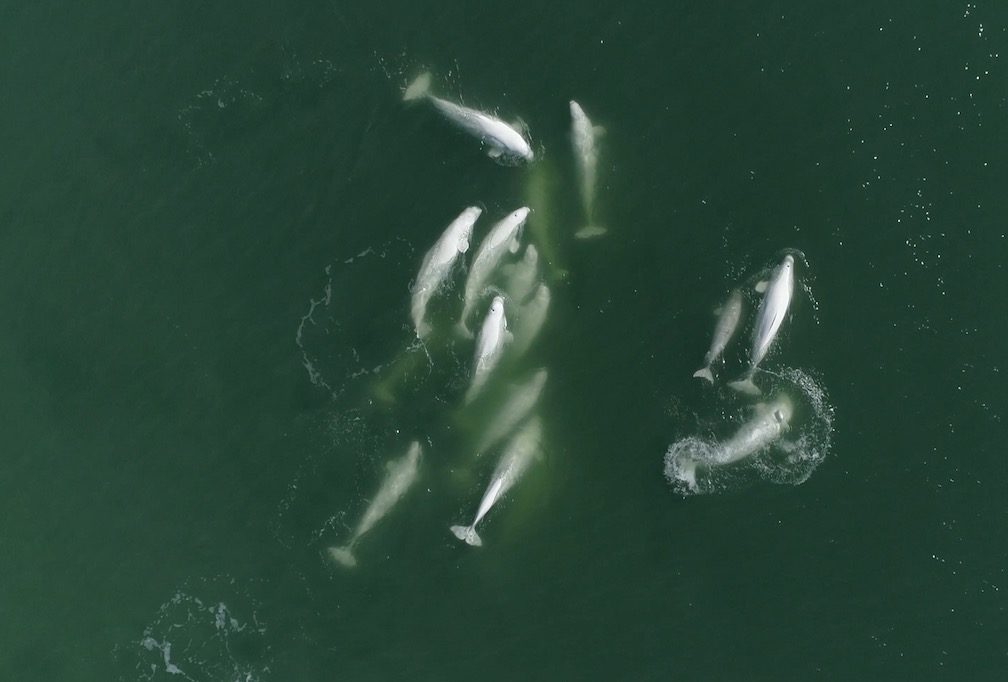Off Les Bergeronnes, a herd of forty to fifty belugas frolic. GREMM Scientific Director and beluga expert Robert Michaud interrupts his report writing to observe the behaviour of these white whales. Some of the animals poke their heads out of the water, others show their tails. The mass of white bodies seems to spin around and slowly drift toward Cap de Bon-Désir. “I don’t know if they’re just feeding or if they’re engaging in social activities. They’re very active on the surface, in any case,” he notes, brimming with pleasure.
Even after more than 35 years of studying them, Robert Michaud still does not know everything there is to know about beluga behaviour. Now that he can use a drone, he has access to a new point of view that allows him to better observe what the animals are doing. “It’s a real revolution,” he says. What might appear to be a single beluga simply surfacing to breath sometimes obscures several other animals playing just below the surface. Throughout the winter, Robert scrutinizes videos and photos to better grasp belugas’ rich and complex social life. These days, his team is actively working to measure belugas based on aerial images.
In Gaspé Bay, a few harbour seals take advantage of the ice. In Havre-Saint-Pierre, ice floes make a brief appearance near the coast, bringing with them a small number of harp seals. An observer who previously worked for many years at the Mingan Island Cetacean Study is taken aback by the behaviour of one of the seals. Its body appears to be skipping across the waves. A hunting foray? A form of play? In any case, it doesn’t seem to be an attempt to get up onto the thin ice.
And then, the storm came in
Then, from February 27 until March 1, eastern Quebec was hit hard by a severe blizzard accompanied by heavy snowfall and gusts of over 100 km/h in some places and, as a result, an impressive swell. “I wonder what whales do in these big storms” ponders Jacques Gélineau, hunkered down in his home in Port-Cartier while outside the roads are rendered impassable by the blowing snow. “Once I was out on the water in a storm with powerful waves. Nowadays, I would never venture out in such weather. I came across a blue whale lingering on the surface. The impact of the waves caused its blubber to move as if it were being hit by a powerful jet of water. Was she getting a cleanse?”
Literature on how whales cope with storms is very scant. More often than not, researchers are unable to track cetaceans under such hostile conditions. A few anecdotal accounts mention whales farther offshore or idling at the surface. A mass stranding of pygmy killer whales in New Caledonia appears to be linked to a hurricane. Researchers believe that a hurricane that passed through the area from January 26 to February 2, 2006 pushed the animals too close to shore.
For bottlenose dolphins in the Mississippi Sound, the passage of a hurricane led to changes in the animals’ foraging patterns. The storm changed the location of their prey, in addition to reducing commercial fishing activity for a certain period. In the year following Hurricane Katrina, bottlenose dolphins were seen in greater numbers.
But do whales experience impacts in smaller storms? Do they get a rush out of being in the immense wave pool that the ocean becomes? How far can the effects of the storm be felt? The development of floating drones or unmanned submarines will perhaps allow us to capture more scenes of life in heavy seas.
On March 2, the storm has subsided, but strong gusts continue to sweep the coast. Not to be deterred, a birder spots four belugas at the end of the day opposite Les Escoumins. Their white backs glisten in the sun, indifferent to the roadways to be cleared and the icy rains that throw the daily lives of humans into disarray.






